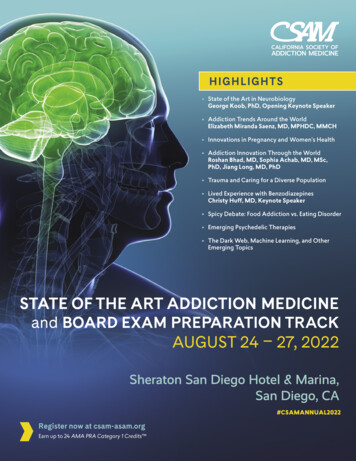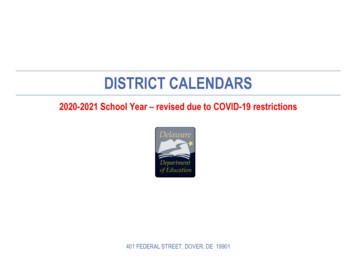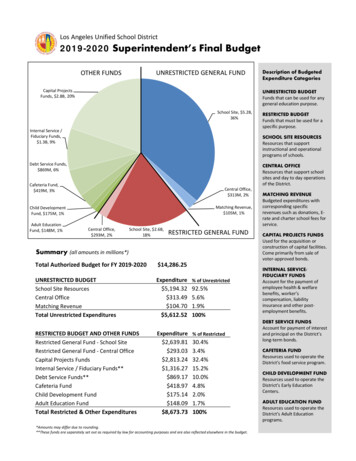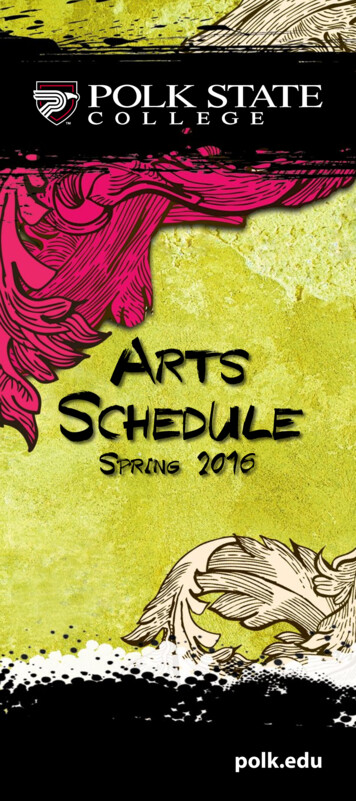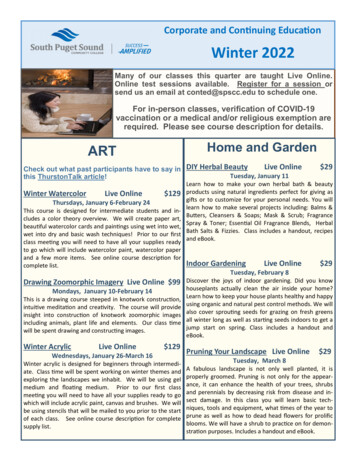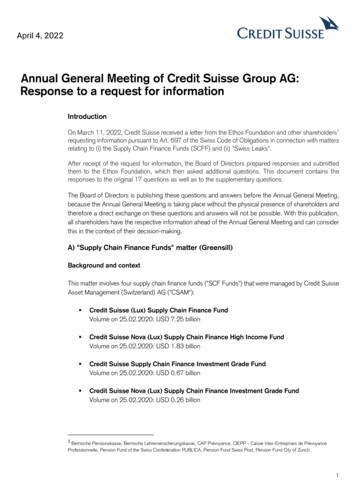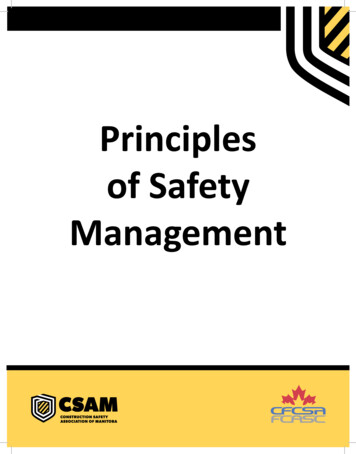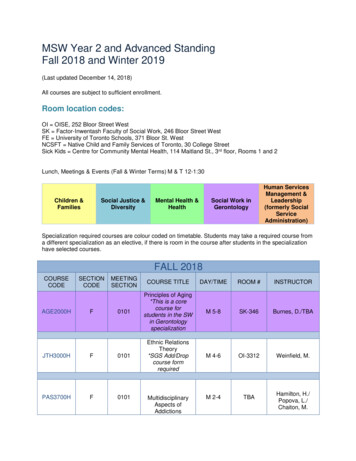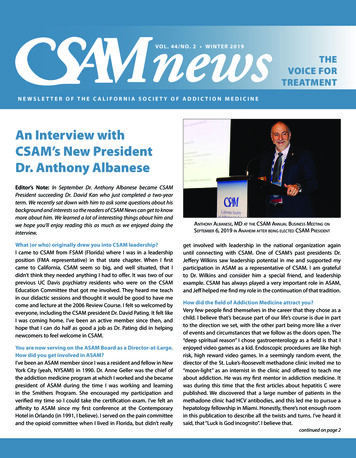
Transcription
newsVO L . 44/NO. 2 W I NTER 2019THEVOICE FORTREATMENTNEWSLETTER OF THE CALIFORNIA SOCIETY OF ADDICTION MEDICINEAn Interview withCSAM’s New PresidentDr. Anthony AlbaneseEditor’s Note: In September Dr. Anthony Albanese became CSAMPresident succeeding Dr. David Kan who just completed a two-yearterm. We recently sat down with him to ask some questions about hisbackground and interests so the readers of CSAM News can get to knowmore about him. We learned a lot of interesting things about him andwe hope you’ll enjoy reading this as much as we enjoyed doing theinterview.What (or who) originally drew you into CSAM leadership?I came to CSAM from FSAM (Florida) where I was in a leadershipposition (FMA representative) in that state chapter. When I firstcame to California, CSAM seem so big, and well situated, that Ididn’t think they needed anything I had to offer. It was two of ourprevious UC Davis psychiatry residents who were on the CSAMEducation Committee that got me involved. They heard me teachin our didactic sessions and thought it would be good to have mecome and lecture at the 2006 Review Course. I felt so welcomed byeveryone, including the CSAM president Dr. David Pating. It felt likeI was coming home. I’ve been an active member since then, andhope that I can do half as good a job as Dr. Pating did in helpingnewcomers to feel welcome in CSAM.You are now serving on the ASAM Board as a Director-at-Large.How did you get involved in ASAM?I’ve been an ASAM member since I was a resident and fellow in NewYork City (yeah, NYSAM!) in 1990. Dr. Anne Geller was the chief ofthe addiction medicine program at which I worked and she becamepresident of ASAM during the time I was working and learningin the Smithers Program. She encouraged my participation andverified my time so I could take the certification exam. I’ve felt anaffinity to ASAM since my first conference at the ContemporaryHotel in Orlando (in 1991, I believe). I served on the pain committeeand the opioid committee when I lived in Florida, but didn’t reallyAnthony Albanese, MD at the CSAM Annual Business Meeting onSeptember 6, 2019 in Anaheim after being elected CSAM Presidentget involved with leadership in the national organization againuntil connecting with CSAM. One of CSAM’s past presidents Dr.Jeffery Wilkins saw leadership potential in me and supported myparticipation in ASAM as a representative of CSAM. I am gratefulto Dr. Wilkins and consider him a special friend, and leadershipexample. CSAM has always played a very important role in ASAM,and Jeff helped me find my role in the continuation of that tradition.How did the field of Addiction Medicine attract you?Very few people find themselves in the career that they chose as achild. I believe that’s because part of our life’s course is due in partto the direction we set, with the other part being more like a riverof events and circumstances that we follow as the doors open. The“deep spiritual reason” I chose gastroenterology as a field is that Ienjoyed video games as a kid. Endoscopic procedures are like highrisk, high reward video games. In a seemingly random event, thedirector of the St. Luke’s-Roosevelt methadone clinic invited me to“moon-light” as an internist in the clinic and offered to teach meabout addiction. He was my first mentor in addiction medicine. Itwas during this time that the first articles about hepatitis C werepublished. We discovered that a large number of patients in themethadone clinic had HCV antibodies, and this led me to pursue ahepatology fellowship in Miami. Honestly, there’s not enough roomin this publication to describe all the twists and turns. I’ve heard itsaid, that “Luck is God incognito”. I believe that.continued on page 2
An Interview with CSAM’s New President Dr. Anthony Albanesecontinued from page 1What was it like working in a methadone clinic early in yourcareer?It was a life-changer! Before I started “moon-lighting” in themethadone clinic, I viewed heroin addicts with the samenegativity that my fellow residents and professors did. Empathyand compassion began once I started seeing the patients asmore than just their medical illnesses. Similarly, working on thedetox unit was immensely impactful. One day while writingdetox orders for a famous baseball player, I muttered under mybreath that I didn’t understand why someone who had fameand fortune would turn to drugs. A nearby nurse heard meand whispered in my ear “well doctor, it’s because you don’tknow anything about addiction”. When I asked her how I couldlearn, she handed me the “Big Book” of Alcoholics Anonymousand challenged me to read the first 164 pages. That was thebeginning of what has been a wonderful career!Tell us a bit about your patients.Over the years I’ve worked with many different patientpopulations. In New York I worked in both indigent and exclusiveaddiction treatment programs. Likewise, in Miami I trainedand worked in the county facility (Jackson Memorial MedicalCenter) while also working at the exclusive addiction treatmentprogram on Miami Beach (Mount Sinai). Six years while I wasin Florida, I was an evaluator for the Impaired Professionalsprograms for physicians, nurses, and lawyers. For the last 18years I’ve been working predominantly with U.S. veterans in theVeterans Health Administration (VHA).You are doing a lot of travel to the East Coast thesedays, why?Over my years working in the VHA, I’ve changed positions manytimes. I’ve gone from being mostly a clinician in Sacramento tobeing an education leader, facility executive, and now am anAffiliations Officer with the VA Office of Academic Affiliations(OAA). Most recently I’ve taken on the role as Acting Chief ofHealth Professions Education, overseeing the clinical aspectsof educating more than 120,000 learners in 40 health relateddisciplines at VAs around the country and in Puerto Rico.Although I love this job, I can’t take it permanently because itwould necessitate a move to Washington DC, where the OAAoffice is located. For now, this means traveling two weeks amonth to Washington, DC until a new Chief of Health ProfessionsEducation is chosen. I still treat patients with liver and addictionproblems in clinic during the weeks I’m back in Sacramento andhave a great team that carries on the work in my absence.What do you consider to be your strengths?I love working as part of a team and fully believe the quote attributed to John Donne that “no man is an island”. My strengths(according to Don Clifton’s Strengthsfinder 2.0 by Tom Rath) are:Connectedness, Belief, Arranger, Positivity, and Relator. If youget the book, you’ll understandwhat that means, AND learnabout your own strengths! Basically, it means that I espouse a“servant leadership” model andenjoy getting people to work together and develop consensus.What (or who) mostinspires you?Finally, an easy question! Thesource of my inspiration is theteachings of Jesus. When He wason this earth He spent the majority of His time healing peopleDr. Albanese and daughterwith physical, emotional, andNicole at Blue Man Groupspiritual disease. He didn’t judgeor condemn anyone except those that looked down on otherpeople. He taught that “messing up” is part of being human, andthat we’d all be in trouble without grace and forgiveness. He modeled “servant leadership”. I’ve learned that spirituality is about relationships (with God and other people), not rules. I would challenge anyone to read the famous Sermon on the Mount and notbe inspired. It will take you 5 minutes and could change your life.Tell us about your spiritual life.I would consider myself a Judeo-Christian. Although I’m notJewish (ok 4% Jewish on Ancestry.com and 73% Italian), theroot of my faith is based in the Jewish religion with the branchesand fruit being what Jesus added when He came 2019 yearsago. I don’t generally get hung-up on the religious rules. Jesussummed up all the laws and commandments when He said tolove God with all your heart, soul, mind and strength and loveyour neighbor as yourself (paraphrased). Pretty simple loveGod and love people.Dr. Albanese with his wife Carol and daughter NicoleWhat are you most proud of?The thing I’m most proud of in my life is my family! I have anawesome wife (for 34 years) and an amazing daughter (age 26).continued on page 72CSAM NEWS WINTER 2019California Society of Addiction Medicine
Low Barrier Buprenorphine for Opioid UseDisorder: A Feasible Strategy to Save Livesand LivelihoodsBy Joseph Mega, MD, MPH (Medical Director, Health Care for the Homeless, Contra Costa County) and Barry Zevin, MD, MPH(Medical Director, Street Medicine and Shelter Health, San Francisco Department of Public Health)The opioid epidemic has had catastrophic effects in California and across the United States and has not peaked.Without aggressive intervention, widespread opioiduse disorder (OUD) and high rates of overdose deaths will continue to be a major problem. Medication Assisted Treatment(MAT) with buprenorphine is a highly effective treatment forOUD. Unfortunately, most individuals with this disease are notcurrently being treated due to poor access, inadequate number of prescribers, onerous program requirements and providerfears.(1-4) In order to offer any hope of adequately addressingthe opioid epidemic, it must be easier to obtain buprenorphinethan synthetic opioids or heroin. The adoption of large-scalelow barrier MAT models could dramatically increase the number of individuals receiving lifesaving treatment.Models of care that lower barriers to treatment have shownremarkable success in Europe and parts of the United States.Deregulation of buprenorphine across France in 1995 was associated with a 79% reduction in opioid overdose deaths overthe subsequent four years.(5) One study that followed a low barrier buprenorphine program in a New York City public hospitalsystem over 7 years showed a median treatment retention of38-weeks with no documented overdose deaths or other serious adverse events.(6) In San Francisco, a Buprenorphine pilotfor patients experiencing homelessness showed over 50% ofpatients retained in care at 6 months.(7)Diagnosing OUD is straightforward in most cases sincemost individuals who use opioids more than on a very occasional basis will meet DSM-5 criteria for moderate to severe OUD.The consequence of missing a diagnosis of OUD and delayingtreatment may be fatal. The consequences of prescribing to apatient whose only intent is to divert, on the other hand, mightbe troublesome, but will readily become evident with electronic records, drug testing and prescription monitoring programs.Care should always be exercised with clear documentation ofhistory, indications for treatment and planned monitoring.Buprenorphine is uniquely suited for low-barrier OUD treatment. Most importantly, buprenorphine is effective in reducingillicit opioid use, reducing mortality and supporting completeabstinence in many patients. Each dose of buprenorphine taken is one less possible instance of overdose, infectious diseasetransmission, or other adverse effect of illicit opioid use. Whilebuprenorphine diversion occurs, it is most often diverted for“clinical” rather than recreational reasons. It has been observedthat availability of buprenorphine in a community of opioid users increases the acceptability of medically prescribed medication.(8-11)www.csam-asam.orgDue to its partial agonist quality and ceiling effect, whenbuprenorphine is used with the intent of “getting high” the riskof fatal overdose is much lower than with any full agonist. Farfewer overdose deaths involving buprenorphine have beenreported in proportion to its prescribing than with any otherprescribed opioid. Buprenorphine has a long half-life and veryhigh mu receptor affinity. Intermittent use is common amongsome patients, but despite this practice of skipping dosing andinstead using illicit opioids, buprenorphine is still present at levels that protect against a fatal overdose.(12)Safe buprenorphine prescribing does, however, still require education for providers and patients, but it is teachable.Buprenorphine initiated too soon after use of full agonists cancause uncomfortable precipitated withdrawal. Ultra-potentsynthetic opioids can overcome the receptor blockade effect ofbuprenorphine and result in overdose even when individualshave been adherent or partially adherent. Opioid tolerance levels naturally drop on buprenorphine and relapse to prior opioiduse can result in overdose. Despite these limitations, evidencefavors continued treatment even when individuals may be intermittently adherent, demonstrating that access to buprenorphine may reduce high risk behaviors in opioid users (13).Barriers to OUD treatment are multifactorial, including issues specific to MAT programs, patients or prescribers, but theseissues vary by community. It is necessary to engage with community members including providers, community health workers, harm reduction agencies, patients, and opioid users whoare not currently in treatment to identify barriers to care. Oftenthis group can recognize local issues related to transportation,stigma or myths within the community; they may have ideas formore accessible MAT locations, such as needle exchanges andemergency departments. Ideally, low barrier MAT means offeringpatients with OUD the opportunity to start buprenorphine thatsame day at any point of interaction with the medical system.By increasing available prescribers, educating providersand ultimately lowering barriers to treatment, we can increasethe amount of buprenorphine available to treat OUD, and inturn, save lives and livelihoods in our communities. REFERENCES:1. Jones C, et al. National and State Treatment Need and Capacity for OpioidAgonist Medication-Assisted Treatment. American Journal of Public Health105, no. 8 (August 1, 2015): pp. e55-e63.2. Beetham T et al. Access to Office-Based Buprenorphine Treatment in Areaswith High Rates of Opioid-Related Mortality: An Audit Study. Ann Intern Med.171:1–9continued on page 11CSAM NEWS WINTER 20193
CSAM Addiction Medicine Review Course andBoard Exam Preparation Track 2019Over 600 attended the CSAM Review Course in Anaheim, September 4-6, 2019. 96% rated it as excellent or very good.ASAM’s President-elect Dr. Bill Haney (left) was a conferenceShown here with Dr. Murtuza Ghadiali (ASAM Region IIrepresentative), Dr. David Kan, Dr. Tony Albanese, andASAM CEO Penny Mills.speaker.Conference Chair Dr. Tauheed Zaman designed the conferenceAdvocates” and he also incorporateda focus on inclusivity.with the theme: “Educators and4CSAM NEWS WINTER 2019The conference planners gathered at the conclusion of the conferenceto share impressions and ideas for next year.California Society of Addiction Medicine
CSAM Addiction Medicine Review Course andBoard Exam Preparation Track 2019The expanded class of scholars who participated in the mentored learning provided by the Medical Education & Research Foundation (MERF). MERFis supported by private donations and some scholars were funded through a SAMSHA State Opioid Response (SOR) grant CSAM received.The youngest conference attendee studying the conference syllabus,attending with her mom Dr. Trisha Schimek.A mobile app was used during the conference to ask questions of speakers, download or email the slides, take notes on the presentations, andconnect with other attendees and presenters.Dr. Romana Zvereva during a break at the conference.Dr. Joe Chudy at one of the facilitated case discussions.www.csam-asam.orgCSAM NEWS WINTER 20195
Timmen Cermak, MD ReceivesVernelle Fox AwardTimmen Cermak, MD was presented with the 2019 VernelleFox award at the 2019 CSAM Addiction Medicine ReviewCourse in Anaheim, CA on Thursday, September 5 during adessert reception at the conference. Nominating Committee ChairMonika Koch, MD presented the award beside CSAM PresidentDavid Kan, MD.He is the 37th recipient of the award following presentation toCSAM’s second President (1974-1976), Vernelle Fox, MD, who washonored in 1983 at the 10th Annual Meeting.Recipients selected are judged to have the qualities Vernelle Foxherself exhibited: an inquiring mind, contributions to the understanding of the field, courage, resolution, tenacity, enthusiasm, and energyfor the positive.Dr. Cermak has been involved as a CSAM Committee member and Committee chair, a board member of CSAM, and Presidentof CSAM from 2009-2011. He has been actively involved in CSAM’sPublic Policy activities and has written many CSAM policy statements over the span of two decades. He has often testified on keylegislation in Sacramento, including recently CSAM’s sponsored billfocused on Youth Treatment (SB-445). He authored numerous CSAMpublications including Standards of Care for Adolescent SubstanceAbuse and the CSAM Youth First Report, published in 2011 prior tothe legalization and regulation of marijuana. The report strongly influenced ASAM’s future direction, and was designed to reduce theharm to young Californians from marijuana use, from ineffective andpunitive regulations, and to address the serious treatment needs ofthose adolescents who become harmfully involved with marijuana.He served on Governor Gavin Newsom’s Blue Ribbon Commission,which established the priority of treating youth substance abuse andProp 64 guaranteed funding to accomplish this goal.He was recently nominated by CSAM and appointed to theProposition 64 Advisory Group within the Department of Health CareServices (DHCS). CSAM member Seth Ammerman, MD was alsoappointed to this Advisory Group. This is an exciting opportunity tobring new tax-funded resources to youth and communities of colormost impacted by the War on Drugs. The state Department of HealthCare Services (DHCS) is in charge of distributing a Youth Fund (YouthEducation, Prevention, Early Intervention and Treatment Account) tosupport substance abuse prevention, intervention and treatment services for youth. The Fund is estimated to be around 119M this yearand is expected to grow to 400- 500 million annually. DHCS is responsible for distributing roughly 21.5 million in the upcoming year(2020) for youth programs.Dr. Cermak is also the author of new book about the science ofmarijuana for clinicians scheduled for release in early 2020 by Cambridge University Press. He has been working on this book for the pastthree years. 6CSAM NEWS WINTER 2019Congratulating Dr. Cermak after receiving the award were (fromleft) Angie Chen, MD, Monika Koch, MD, Tim’s wife Mary,Steve Eickelberg, MD, Gail Jara, David Kan, MD, Anita Renzetti,Kerry Parker, and Jean Marsters, MD.CSAM’sMembership NowTops 700!This past year, CSAM hit a milestone reaching 700members, and nearly doubling the number of members it had in 2010. Similarly, the American Society ofAddiction Medicine (ASAM) has more than doubledfrom less than 3,000 in 2010 to over 6,500 in 2019.With this growing membership combined with thespecialty of Addiction Medicine becoming an ABMSboard-recognized sub-specialty in the American Boardof Preventive Medicine, CSAM is eligible to earn a seatin the Specialty Society Delegation of the CaliforniaMedical Association (CMA). To earn the seat, 35% ofCSAM’s voting members must also hold membershipin CMA. We need your support achieving this goal —CSAM needs just 40 more of its members to join CMAand your County Society.To join, contact the CMA Member Resource Centerat: 800-786-4262 or go to:https://www.cmadocs.org/joinCalifornia Society of Addiction Medicine
CSAM Community Service Award Goes to DavidLisonbee, CEO of Twin Town Treatment CentersThe CSAM Community Service Award is presented to anon-physician who has made outstanding contributionsto the community. This year’s recipient, David Lisonbee,has for many years given help to those with substance use disorders. Mr. Lisonbee is President and Chief Executive Officer of TwinTown Treatment Centers, which operates a network of six Los Angeles and Orange County based outpatient addiction treatmentprograms. The programs he has established take outstandingcare of a wide range of patients across Los Angeles.There are several additional reasons he merited CSAM’s recognition. Mr. Lisonbee has always been committed to quality—he has promoted quality within his programs and has advocatedfor it across Los Angeles at large. He has always had an unequivocal commitment to maintaining access to patients who are disenfranchised. Through enormous ups and downs in the regulatory,policy, and financial environment over the decades, he has designed and refined his programs to maximize access for patientswith limited means.In a field dominated by a recovery orientation that sometimes regards medical interventions, particularly medications,with weariness and suspicion, Mr. Lisonbee was an early adopterof medication treatments for opioid and alcohol use disorders.He read the literature, and he got behind the science from theoutset. Mr. Lisonbee has had a fundamental commitment topromote adoption of evidenced based interventions. He has expressed this commitment not only by ensuring that his programsMonika Koch, MD, Chair of the CSAM Awards Committee, andDavid Kan, MD, present the CSAM Community Service award toDavid Lisonbee.follow best practices, but also by partnering with academic physicians to formally study and evaluate the impact of interventionson patient outcomes.Having both personal and professional investment in addiction recovery, Mr. Lisonbee is an advocate for the addiction treatment profession, which includes fostering consumer, regulatoryand political initiatives. Through his personal commitment, intelligence, persistence, and ingenuity, he has served as a modelfor advancing high quality care. His work has impacted the livesof countless individuals and families with addiction, and he hasraised the standard of care in our community. CSAM thanks Mr.Lisonbee for these important achievements. An Interview with CSAM’s New President Dr. Anthony Albanesecontinued from page 2Great families don’t just happen, they are grown with great care,wise choices, and lots of effort. When I look at my wife (who is aPM&R physician and professor at UC Davis) and daughter (whojust finished her MPH at Columbia University), I’m simultaneouslyfilled with pride and gratitude.What are your hobbies?I love to travel! My wife and I have been to 6 of the 7 continents(Antarctica here we come) and done medical work in several ofthem. I love music and play bass guitar as many of you know fromprevious CSAM retreats (still play in church many weeks). We’veenjoyed hiking, scuba diving and skiing over the years, but someof these things are diminishing as we get older. We love to eat!When we travel, we look up places from “Diners, Drive-Ins andDives” or “The Best Thing I Ever Ate”.What do you read?I like books on leadership, improving relationships, and recovery.One of my favorite books ever is a novel, “The Shack” by WilliamPaul Young. It’s a mind-bending book that portrays God as anwww.csam-asam.orgAfrican-American woman. Professionally, I keep up with a fewjournals regularly including JAMA, JAM, Hepatology, and LiverTransplantation, and do a lot of “just in time” learning with PubMed, Google Scholar, and Up-to-Date.What do you want CSAM to look like when youcomplete your term as president?We recently revised our CSAM Mission and Vision Statements,published at www.csam-asam.org. My goal is to serve ourorganization by making those statements happen. With theconversion of ADM certification going to fellowship-basedtraining rather than practice-based training, CSAM is going toget leaner. We need to learn how to expand our influence withless income from the usual sources (conferences). We need toattract and engage ADM fellows and all practitioners interestedin learning more about Addiction Medicine. We need to continueto innovate and be the voice of evidence-based prevention andtreatment as we advocate for our members and patients. My goalis to enact our mission, vision, and the items approved by theCSAM Board on the current and future Strategic Plans. CSAM NEWS WINTER 20197
MERF Provides 54 Scholarships to 2019Addiction Medicine Review Course in AnaheimBy Ken Saffier, MD, FASAM, President, The Medical Education and Research Foundation (MERF) for the Treatment for AddictionWhat is MERF?MERF was established in 1981 “to increase and improve the education of physicians about alcoholism and other drug dependencies” — specifically about the evidence, the science, and how toapply it to patients. We particularly stress the clinical continuumof diagnosis, treatment and recovery for the patient and theirfamily members. This year, MERF accepted applications from21 residents, fellows and faculty to attend the CSAM AddictionMedicine Review Course in Anaheim, Sept 4-7, and participatein an intensive and interactive learning experience led by addiction medicine specialists designed to improve the education ofthese physicians about all aspects of addiction, including harmful drinking or drug use, medical sequelae, family impact, as wellas recovery and how to support it. This group of scholars wasfunded by the generous donations from CSAM members and thecommunity.In addition, MERF also accepted applications from 33 practicing clinicians funded by the CA Department of Health CareServices (DHCS) through a SAMHSA State Opioid Response (SOR)grant for the purpose of expanding the use of Medication Assisted Treatment (MAT) in California. For this year’s group of scholars (MERF MATES) we provided “mentored learning experiences”(MLEs), with addiction medicine specialists, conference registration, a Motivational Interviewing pre-conference workshop, anda stipend toward travel and lodging. A mentored learning experience included facilitated small table discussions, sharing common MAT questions and approaches to exploring primary caresolutions.Additionally, Residency Programs describing their academicand clinical work submitted ten research posters. These were displayed in the Exhibit Hall and were judged by a panel of CSAMmembers led by Ingeborg Schafhalter, MD.How does an “MLE” enhance learning during the conference?To enhance the educational value for residents, fellows and faculty, as well as the practicing clinicians most whom work in FQHC(federally qualified health centers), MERF began the experiencewith an orientation session by one of its Board members, JulieNyquist, PhD, Professor of Medical Education, USC Keck School8CSAM NEWS WINTER 2019of Medicine, to review and promote MERF’s goals as well as individuals’ learning goals. This was followed by a workshop on Motivational Interviewing led by Catalina Triana, MD, and me, toofficially begin their immersion in addiction medicine (ADM). Weencouraged networking among the scholars by region and bytheir clinical needs and interests which they expressed before theconference by submitting challenging cases as part of their application process. These were then addressed in our morning casediscussions, held before the conference plenary sessions, and ledby our MERF table and education facilitators. Also, scholars engaged in a vibrant case discussion with two of the plenary speakers, Soraya Azari, MD, and Andrea Rubinstein, MD, about painmanagement in the context of an opioid use disorder.Also, for the first time, MERF matched participants with CSAMmembers to extend their learning with clinical ADM experts. Thismatching is to help scholars get acquainted with ADM specialistsso that future opportunities for mentoring or networking mighttake place. This matching of scholars with CSAM members will becontinued in future years.How Does the Mentoring Continue?With this year’s conference over, and all of us left inspired to expand our ADM curricula and clinical practices, this is only the beginning, rather than the end of our MERF educational enhancement. We will continue developing mentoring relationships byholding quarterly journal club meetings online where we: continue our networking and reporting on our clinical and educationalgoals and, have a first author of a relevant journal article make a10-minute presentation before a 20-30-minute discussion.MERF has been fortunate to receive another year of funding from DHCS for 2020 to help us continue to offer MERF MATEscholarships. At this year’s conference MERF received 10,160 inprivate donations to fund scholarships for residents, fellows, andfaculty to attend. We continue to rely on private donations tocontinue this important work, so we encourage all CSAM members and former MERF Scholars to make tax-deductible contributions to keep our progress and education moving forward! Tomake a donation or for questions or suggestions, please email usat: MERFadmin@gmail.com. California Society of Addiction Medicine
The expanded class of scholars who participated in the mentored learning provided by the Medical Education & Research Foundation (MERF). MERFis supported by private donations and some scholars were funded through a SAMSHA State Opioid Response (SOR) grant.2019 CLASS OF TRADITIONALMERF SCHOLARS(funded by private donations)Angelo Asheh, DO, PA, MS - La Jolla, CAStephanie Castillo, MD - San Diego, CAAlbert Cheng, MD - Las Vegas, NVGrace Gu, MD - Las Vegas, NVRachael Harlos, MD - Martinez, CAAnna Haynes, MD - Harbor City, CAMariel Janowsky, MD, MPH - San Diego, CATatjana Josic, MD - Los Angeles, CAKanwardeep Kaleka, MD, PhD - San Diego, CAMariya Masyukova, MD, MS - Bronx, NYTatiana Mefford, MD - Stanford, CAMatthew Meyers, MD, MPH - San Francisco, CAAlexander Phan, DO - Modesto, CADarren Rahaman, MD - Las Vegas, NVAkbar Rahman, MD, MPH - San Diego, CAJanelle Rodriguez, MD, MS, MPH - Los Angeles, CAAndrea Silva, MD - Modesto, CAApril Soto, MD - Los Angeles, CAMeg Tabaka, MD, MPH - San Jose, CALaura Ucik, MD - Bronx, NYRegina Wang, MD - San Diego, CA2019 MERF MENTORSSteve Eickelberg, MD - Tucson, AZAnna Lembke, MD - Stanford University, Palo Alto, CAL
wwwcsam-asamorg CSAM NEWS WINTER 20193 Low Barrier Buprenorphine for Opioid Use Disorder: A Feasible Strategy to Save Lives and Livelihoods by Joseph MegA, MD, Mph (MeDiCAl DireCtor, heAlth CAre for the hoMeless, ContrA CostA County) AnD bArry Zevin, MD, Mph (MeDiCAl DireCtor, street MeDiCine AnD shelter heAlth, sAn frAnCisCo DepArtMent of publiC heAlth) he opioid epidemic has had catastrophic .
